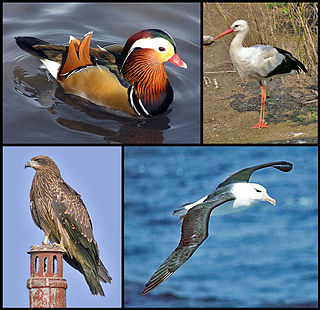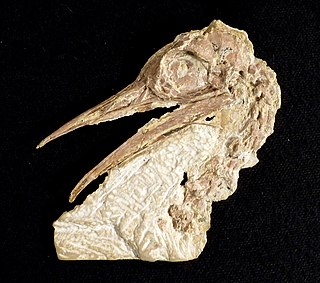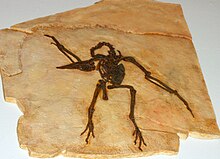
A ratite is any of a group of mostly flightless birds within the infraclass Palaeognathae. They are mostly large, long-necked, and long-legged, the exception being the kiwi, which is also the only nocturnal extant ratite.

The mousebirds are birds in the order Coliiformes. They are the sister group to the clade Cavitaves, which includes the Leptosomiformes, Trogoniformes (trogons), Bucerotiformes, Piciformes and Coraciformes. This group is now confined to sub-Saharan Africa, and it is the only bird order confined entirely to that continent, with the possible exception of turacos which are considered by some as the distinct order Musophagiformes, and the cuckoo roller, which is the only member of the order Leptosomiformes, and which is found in Madagascar but not mainland Africa. Mousebirds had a wider range in the Paleogene, with a widespread distribution in Europe and North America during the Paleocene.

Ostriches are large flightless birds. They are the heaviest and largest living birds, with adult common ostriches weighing anywhere between 63.5 and 145 kilograms and laying the largest eggs of any living land animal. With the ability to run at 70 km/h (43.5 mph), they are the fastest birds on land. They are farmed worldwide, with significant industries in the Philippines and in Namibia. Ostrich leather is a lucrative commodity, and the large feathers are used as plumes for the decoration of ceremonial headgear. Ostrich eggs have been used by humans for millennia.

Palaeognathae is an infraclass of birds, called paleognaths or palaeognaths, within the class Aves of the clade Archosauria. It is one of the two extant infraclasses of birds, the other being Neognathae, both of which form Neornithes. Palaeognathae contains five extant branches of flightless lineages, termed ratites, and one flying lineage, the Neotropic tinamous. There are 47 species of tinamous, five of kiwis (Apteryx), three of cassowaries (Casuarius), one of emus (Dromaius), two of rheas (Rhea) and two of ostriches (Struthio). Recent research has indicated that paleognaths are monophyletic but the traditional taxonomic split between flightless and flighted forms is incorrect; tinamous are within the ratite radiation, meaning flightlessness arose independently multiple times via parallel evolution.

Neognathae is an infraclass of birds, called neognaths, within the class Aves of the clade Archosauria. Neognathae includes the majority of living birds; the exceptions being the tinamous and the flightless ratites, which belong instead to the sister taxon Palaeognathae. There are nearly 10,000 living species of neognaths.

The evolution of birds began in the Jurassic Period, with the earliest birds derived from a clade of theropod dinosaurs named Paraves. Birds are categorized as a biological class, Aves. For more than a century, the small theropod dinosaur Archaeopteryx lithographica from the Late Jurassic period was considered to have been the earliest bird. Modern phylogenies place birds in the dinosaur clade Theropoda. According to the current consensus, Aves and a sister group, the order Crocodilia, together are the sole living members of an unranked reptile clade, the Archosauria. Four distinct lineages of bird survived the Cretaceous–Paleogene extinction event 66 million years ago, giving rise to ostriches and relatives (Palaeognathae), waterfowl (Anseriformes), ground-living fowl (Galliformes), and "modern birds" (Neoaves).

Palaeotis is a genus of paleognath birds from the middle Eocene epoch of central Europe. One species is known, Palaeotis weigelti. The holotype specimen is a fossil tarsometatarsus and phalanx. Lambrect (1928) described it as an extinct bustard, and gave it its consequent name. After a suggestion by Storrs L. Olson, a review of the type specimen and the referral of several other fossils by Houde and Haubold (1987) concluded that Palaeotis is a palaeognath and assigned it to the same order as ostriches; the Struthioniformes. In 2021, it was considered a member of the family Paleotididae alongside Galligeranoides from the Early Eocene of France, which were found to be basal members of the Struthioniformes.
Limenavis is a prehistoric bird genus from the Late Cretaceous. It lived about 70 million years ago, around the Campanian-Maastrichtian boundary. Known from several broken bones, the remains of the only known species Limenavis patagonica were found in rocks of the "lower member" of the Allen Formation at Salitral Moreno, 20 km south of General Roca, Río Negro (Argentina). It is the closest relative, in the fossil record, of the modern birds.
Paleontology or palaeontology is the study of prehistoric life forms on Earth through the examination of plant and animal fossils. This includes the study of body fossils, tracks (ichnites), burrows, cast-off parts, fossilised feces (coprolites), palynomorphs and chemical residues. Because humans have encountered fossils for millennia, paleontology has a long history both before and after becoming formalized as a science. This article records significant discoveries and events related to paleontology that occurred or were published in the year 1984.
Paleontology or palaeontology is the study of prehistoric life forms on Earth through the examination of plant and animal fossils. This includes the study of body fossils, tracks (ichnites), burrows, cast-off parts, fossilised feces (coprolites), palynomorphs and chemical residues. Because humans have encountered fossils for millennia, paleontology has a long history both before and after becoming formalized as a science. This article records significant discoveries and events related to paleontology that occurred or were published in the year 1979.
Paleontology or palaeontology is the study of prehistoric life forms on Earth through the examination of plant and animal fossils. This includes the study of body fossils, tracks (ichnites), burrows, cast-off parts, fossilised feces (coprolites), palynomorphs and chemical residues. Because humans have encountered fossils for millennia, paleontology has a long history both before and after becoming formalized as a science. This article records significant discoveries and events related to paleontology that occurred or were published in the year 1976.

The Phaethontiformes are an order of birds. They contain one extant family, the tropicbirds (Phaethontidae), and one extinct family Prophaethontidae from the early Cenozoic. Several fossil genera have been described, with well-preserved fossils known as early as the Paleocene. The group's origins may lie even earlier if the enigmatic waterbird Novacaesareala from the latest Cretaceous or earliest Paleocene of New Jersey is considered a tropicbird.
Diogenornis is an extinct genus of ratites, that lived during the Early Eocene. It was described in 1983 by Brazilian scientist Herculano Marcos Ferraz de Alvarenga based on fossils found in the Itaboraí Formation in southeastern Brazil. The type species is D. fragilis. It grew to about two thirds the size of the modern greater rhea, at about 90 centimetres (3.0 ft) of height.

Dasornis is a genus of prehistoric pseudotooth birds. These were probably close relatives of either pelicans and storks or waterfowl; they are placed in the order Odontopterygiformes to account for this uncertainty.

Lithornis is a genus of extinct paleognathous birds. Although Lithornis was able to fly well, their closest relatives are the extant tinamous and ratites.
Paracathartes is a genus of extinct bird from the Wasachtian horizon of lower Eocene Wyoming. One species, Paracathartes howardae has been described.

Pseudocrypturus is a genus of extinct paleognathous bird. One species is known, Pseudocrypturus cercanaxius. It is a relative of such modern birds as ostriches. It lived in the early Eocene. The holotype fossil is in the collection of the Smithsonian's National Museum of Natural History. It has catalog number USNM 336103. It was collected from the Fossil Butte Member, Green River Formation, Lincoln County, Wyoming.
Calciavis is an extinct genus of bird from the Eocene of Wyoming. It is a lithornithid, a member of a lineage of flying palaeognaths, distantly related to modern ratites. Like many other fossils from the Green River Formation, its are exceptionally well preserved, bearing impressions of skin and feathers.
Geranoididae is a clade of extinct birds from the early to late Eocene and possibly early Oligocene of North America and Europe. These were mid-sized, long-legged flightless birds. Recent research shows that these birds may actually be palaeognaths related to ostriches.














